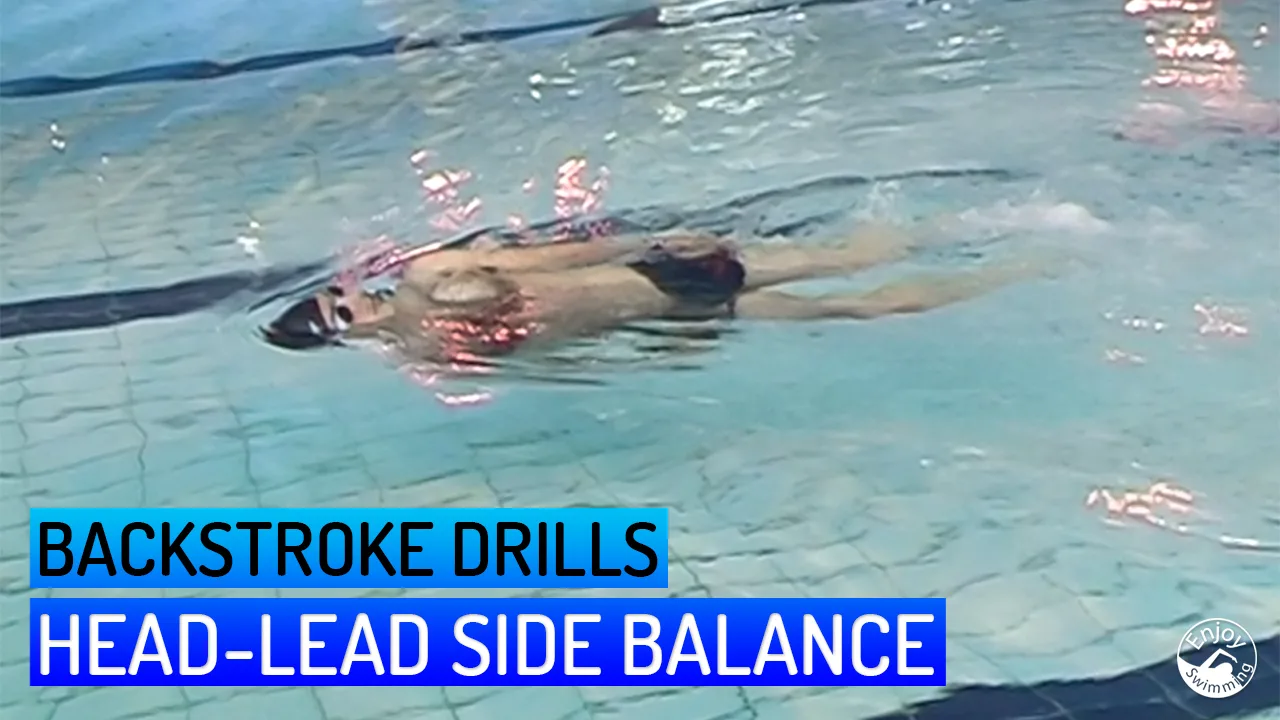Head-lead side balance drills are the next swimming drills in our series of backstroke swimming drills.
With these drills, you’ll practice floating more on the side rather than floating flat on your back. A relaxed flutter kick is used for propulsion.

Swimming on the Side?
If you observe a backstroke swimmer with attention, you’ll notice that he doesn’t keep his back parallel to the water surface, but that he instead rolls from to side to side towards the pulling arm.
If you are new to backstroke this might surprise you, but there are several good reasons to do this:
- It allows engaging the bigger chest and back muscles in addition to the shoulder muscles, giving better propulsion.
- It puts less strain on the shoulder and helps prevent the swimmer’s shoulder injury.
- As the shoulder of the recovering arm clears the water, less drag is produced in the water.
- The momentum generated by the body roll provides additional power to the arms and legs.
But let’s get back to our side balance drills. Subsequent drills will cover the arm movements.
Swimming Drill: Head-Lead Side balance
The side position you are aiming for is somewhere between being flat in the water with the back and being rotated 90° away from the water surface.
The exact position will be different for each swimmer, but for most people, the angle lies somewhere between 30 and 45°.
Here’s a video of the first drill:
The drill starts exactly like head-lead supine balance:
- Go to the shallow area of the pool.
- Push off the ground and lie on your back in the water.
- Keep the arms at your side.
- Start to flutter kick for propulsion.
- Try to get your body in a straight line from head to toes. Remember to push down the back of the head and upper back into the water if the legs and hips tend to drop.
- Look straight up towards the ceiling or sky.
Once you are comfortable on your back, roll more into a side position:
- Roll from shoulders to toes so that the body is at an angle somewhere around 45° compared to the water surface.
- Everything rolls except the head which should stay in place. You should still be looking straight up.
- To roll the body, kick harder with one leg than the other. Don’t use your arms, always keep them at your sides.
- Experiment with various angles of rotation to find the most comfortable position.
- To keep your legs and hips up, you’ll have to change the point where you push your upper body down in the water for leverage. The point will be located somewhere between the spine and the bottom shoulder.
- Practice this drill on each side, changing sides each length, until you are comfortable and can keep the balance on the side forever.
Swimming Drill: Rolling from Side to Side
Once you can comfortably keep your side balance for the whole length, try to roll from side to side every few kicks.
This will add a dynamic component to the swimming drill where you must adjust your balance as you roll from side to side.
Take your time to master this drill until you feel comfortable rolling from side to side. Remember to look straight up towards the ceiling all the time.
Conclusion
The main difficulty when you learn to swim backstroke is to keep your balance while floating on the back.
Once you have mastered the swimming drills up to the ones on this page, you’ll already be a long way towards that goal.
The next step we will be to add arm movements, which we’ll cover in the following drills.
Learning Path for the Backstroke
Below is an overview of our series of articles on learning the backstroke. Each article in this series contains one or more drills that have to be mastered. The current article is highlighted:
Once you have gone through all the steps of this learning path, you should be able to swim backstroke without any problems.
Good luck!
